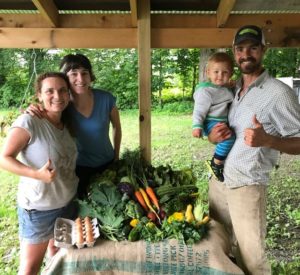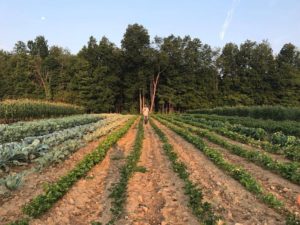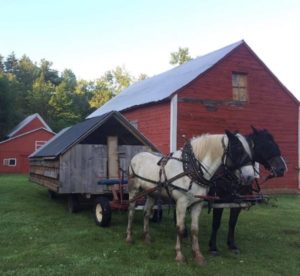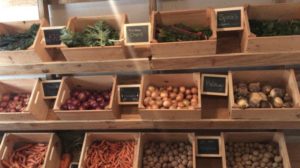Featherbed Lane Farm’s Profit Team Experience
A Profit Team Case Study
Featherbed Lane Farm is a diversified vegetable operation offering a full-year CSA to members. The farm is also home to a flock of hens that produces eggs for CSA members, and two draft horses, Bear and Duke, who support production. Sited on 60 acres of mixed woods, wetlands and fields, the farm is located in Ballston Spa, NY. In 2017, it served 45 full-year CSA members, with a goal of scaling up in 2018 to provide for 75 members.
Owner Tim Biello began planning for his farm business in 2010. Like many farmers, it took time to find the right property. Tim searched for about five years before landing in Ballston Spa. During that time, he explored a variety of strategies to secure financing, which led him to work with The Local Farms Fund. The Local Farms Fund would buy a property outright, with a lease-to-own arrangement and an option to purchase the site five years later. After four years of searching while keeping the draft horses on other properties, Tim either needed to find them a permanent home or sell the team. Not wanting to sell, he set a motto: “bringing home the team in 2015.” That same year, Tim found a place that met both the business and personal goals he had set forward, and Featherbed Lane Farm was launched.
Profit Team Project Overview
With a strong focus on securing land for the business, Tim’s profit team project encompassed two efforts. Tim explained, “One was to help really plan for buying the farm and… for putting together a conservation easement that would be part of protecting that land long term as well as making it more affordable for me in the current time.” He continued to explain that “the second part of the project ended up coming back to one of my original goals which was to work with a consultant to help me update and better understand my numbers to be able to use them more effectively for decision making.”
To apply for a conservation easement, Tim worked with the land trust, Saratoga PLAN, and an attorney to complete the necessary paperwork. This helped him identify language and strategies to ensure long-term preservation of the land, while considering the needs of current and future farmers. In focusing on finances, he collaborated with a business consultant to help evaluate scenarios for finances leading up to the purchase of his property. Developing these financial metrics helped Tim plan for the present and the future of the farm. In reflection, he noted that while he had started this type of analysis on his own, this project provided an opportunity to work with “somebody who had a lot more expertise looking at farm financial numbers to help me streamline how I kept records … to better understand if my business was succeeding or not.”
Unlike many other profit teams, there was little change in the goals of Tim’s project from start to finish. He attributed this to a lot of planning, but also acknowledged that it simply was the logical course forward for operational stability.
Results
As of 2018, Tim is near to closing on an easement and has a much clearer picture of current and future finances. These two efforts have helped Tim position the farm so that he can soon shift his attention towards investments to infrastructure and operations.
The conservation easement will preserve the property in the long term and reduce costs for rent and a future mortgage. This was taken into account when deciding to
acquire the property and will be a component of making the land affordable for Tim to purchase.
In planning ahead for purchase in 2020, Tim also met with a consultant to review and update financial projections. He explained that it can be particularly tough for new farms, stating “we’re getting to a stage where we might move into the black soon, but it’s all thin margins.” He continued to explain that there are a lot of costs with farm start-up and sometimes farm income does not allow for a wide margin of error. Therefore clearly projecting costs and revenues, and establishing strong financial management systems is very important.
A Closer Look at Conservation Easements

Tim and his son, Finnegan, with Tory and Toni, the CSA Manager and Farm Assistant, at a CSA pickup. Courtesy of Featherbed Lane.
Through an ongoing search for land, Tim explored many methods to secure funding. Ultimately, he determined that the best approach for his farm was a lease-to-own agreement with the Local Farms Fund, and pursuing a conservation easement on the farmland to make the purchase more affordable.
What, specifically, is a conservation easement? It is a farmland protection tool that prevents farmland from being developed. One of the purposes of the program in New York State (NYS) is to protect viable agricultural lands and conserve the land for agricultural use forever.
In considering protecting one’s land with a conservation easement, the first step is to find a land trust or municipality to work with. The land trust or municipality will hold the easement and ensure that the terms of the easement are carried out. Through his project, Tim worked with his local land trust and briefly with the town, due to some restrictions in the NYS program. In the end, the land trust was able to hold the easement and further work with the town was not pursued.
In exchange for the easement, a land owner is paid for the value of the development rights of the property. The money for this in New York is often provided through a state grant. For a beginning farmer like Tim, the payment for the development rights will make the farm more affordable in the short and long-term. Money received from the payment will be applied to the principle on the Local Farms Fund’s mortgage, reducing rent costs for Tim. When the option to buy is available in 2020, Tim will then have to borrow significantly less money for a mortgage.
Although conservation easements offer a number of benefits, there are some considerations one should keep in mind before pursuing this option. It is important to note that one should make sure the terms of the easement are compatible with your goals for the farm. To navigate this process, and develop language that supports these goals, it is recommended to consult with a knowledgeable attorney. One should also keep in mind that only a few easements are issued per year, and the process can take up to several years. Properties must also be located in an agricultural district to be eligible.
Strategies for Success
Tim’s business planning strategies can be applied at other farm operations.
- Stay focused. From the project’s initiation, Tim had identified that he wanted to pursue a conservation easement and evaluate financials for future farm planning. His laser-like focus has carried this strategy forward, and Tim is now closer to realizing the success of these efforts.
- Use supporting data to make clear decisions. In working with a consultant to review finances, Tim was able to enhance existing projections about business goals. Based on this information, he held-off on making large financial investments in infrastructure and focused on securing the property first. He noted that if he had more time and funding, he would also like to work with a consultant to evaluate pricing for the CSA. Similar to his overall farm approach, he has tracked labor hours and builds on past knowledge to set share prices. He pointed out that bringing in an outside perspective might, however, offer a different way to interpret the data that informs his decisions.
- Follow a phased approach for planning. Since finding the property in 2015, Tim has focused on securing a conservation easement for Featherbed Lane Farm. Once he purchases the property, he indicated that he would like to next focus on enhancing the site’s infrastructure. A new multi-purpose building could provide space for an indoor packing area, a CSA pick-up, and more. While this would improve efficiency and comfort, Tim has recognized the need to follow a step-by-step process, first securing property, and then enhancing infrastructure.
Information for this case study was collected in February 2018. For more information about the Profit Team Project, please visit https://smallfarms.cornell.edu/projects/profit-teams/. This project was a collaboration of the Cornell Small Farms Program, NY Farm Viability Institute, and NY FarmNet, and made possible with funding from the National Institute of Food and Agriculture, U.S. Department of Agriculture, under award number 2015-70017-22882.




